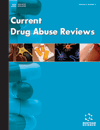-
oa Editorial (Alcohol, Drugs, and Diving: Implications for Health and Fitness to Dive)
- Source: Current Drug Abuse Reviews, Volume 5, Issue 2, Jun 2012, p. 85 - 86
-
- 01 Jun 2012
Abstract
Recreational diving is an increasingly popular leisure activity. It has been estimated that U.S.A. has 1.2 million recreational scuba divers, and this number grows annually [1]. In addition to recreational divers, there is also a growing number of professional divers. Diving is a potentially dangerous activity, which is why divers should be trained and certified. Hyperbaric circumstances itself may negatively affect cognitive and psychomotor functioning [2]. One of the problems divers may experience is nitrogen narcosis, i.e. an altered state of mind, caused by breathing nitrogen at a high partial pressure. Narcotic effects start to appear at a pressure of 4 bar (30 meters of depth) [3]. This effect has been popularly called the “Martini effect”, since it has been argued that each 10 meters of diving depth corresponds to a performance impairment as produced by one glass of alcohol. So, at 40 meters of depth, a diver feels and functions like he has consumed 4 alcoholic drinks. It is therefore understandable that various rules apply at diving schools to ensure the health and safety of the diver. One of these rules is that divers should not use alcohol, medicinal or recreational drugs around the time of diving. Psychoactive drugs may have adverse effects such as drowsiness or dizziness that interfere with safe diving. Despite rules and recommendations not to use drugs and dive, a great number of divers disregard this advice and report diving shortly after using prescribed or over-the-counter drugs. More than half of N=531 surveyed U.K. divers reported taking overthe- counter drugs within 6 hours before diving, of which analgesics and decongestants were most commonly reported. About 1 in 4 divers reported using prescription drugs within 6 hours of diving [4]. These drugs included cardiovascular and respiratory drugs, but also drugs that cross the blood brain barrier such as anxiolytics, antidepressants, and antihistamines. 26% of divers further reported consuming alcohol within 12 hours before diving. In a second publication, St Leger Dowse et al. reported on illicit drug use among UK divers [5]. Although the absolute numbers of drugged divers was low, the use of cannabis, cocaine and ecstasy within 6 hours before diving was reported. Of N=105 divers who reported illicit drug use, 22 did so within 24 hours before diving. These recent data are a reason for concern, since they show that divers do not take regulations and recommendations regarding drug use seriously. Similar data was also reported in studies with Australian divers [6,7]. On land, the pharmacodynamic effects of drugs have been thoroughly investigated. A great number of medicines, alcohol and illicit drugs have adverse effects that compromise daily activities such as driving a car [8,9]. Other drugs however are devoid of these adverse effects, or may even improve performance [10]. Therefore, if a patient wishes to drive a car or is involved in other potentially dangerous daily activities, physicians often can make a choice between the available treatment options. For example, regarding drugs and driving the International Council on Alcohol, Drugs and Traffic Safety categorized drugs into class 1, 2 or 3 to indicate whether driving is safe or not when treated with a particular drug (www.icadts.org)....


